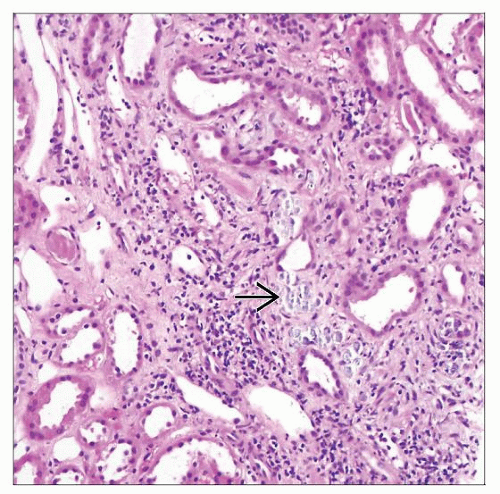Nephrocalcinosis
Lynn D. Cornell, MD
Key Facts
Terminology
Deposition of abundant calcium phosphate precipitates within renal tubules and interstitium
“Nephrocalcinosis” usually refers to calcium phosphate deposits in setting of hypercalcemia
Etiology/Pathogenesis
Hypercalcemia due to various conditions
Nephrocalcinosis usually in setting of chronic hypercalcemia
Inherited tubulopathies
Clinical Issues
Chronic renal failure
Hypercalcemia
Hypercalciuria
Image Findings
Diffuse, fine renal parenchymal calcifications
Microscopic Pathology
Calcium phosphate deposits within tubular lumens, interstitium, and tubular basement membranes
Deposits are purple on H&E stained sections
Deposits are positive (black) on von Kossa stain, which stains phosphate
Interstitial fibrosis and tubular atrophy and interstitial inflammation
Top Differential Diagnoses
Phosphate nephropathy
Usually related to ingestion of oral sodium phosphate
TERMINOLOGY
Definitions
Deposition of abundant calcium phosphate precipitates within renal tubules, tubular basement membrane, and interstitium
“Nephrocalcinosis” usually refers to calcium phosphate deposits in setting of hypercalcemia
Calcium oxalate deposits in other conditions (e.g., primary hyperoxaluria, usually termed “oxalosis”)
ETIOLOGY/PATHOGENESIS
Calcium Precipitation Within Kidney
Increased urinary concentration of calcium and phosphate that allows for precipitation
Almost all calcium (98%) filtered by glomerulus is reabsorbed by tubule
Randall plaques (calcium deposits at or near papillary tip) may be initial site of calcification, at least in some types of nephrocalcinosis
Randall plaques show deposits in interstitium, tubular basement membranes, and tubular lumens
Hypercalcemia Due to Various Conditions
Nephrocalcinosis usually in setting of chronic hypercalcemia
Sarcoidosis
Hypercalcemia of malignancy
Milk-alkali syndrome
Hypervitaminosis A or D
Hyperparathyroidism (primary)
Inherited Tubulopathies
Dent disease, cystinosis, and others
CLINICAL ISSUES
Epidemiology
Age
Childhood through older adulthood
Neonates, especially those receiving loop diuretics
Presentation
Chronic renal failure
Nephrolithiasis
Not always present
No or little proteinuria
Benign urine sediment
Hypercalcemia
Hypercalciuria
Nephrocalcinosis may be found in presence of other renal disease
Stay updated, free articles. Join our Telegram channel

Full access? Get Clinical Tree







